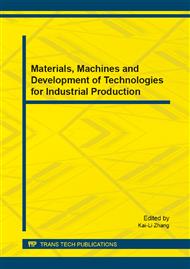[1]
Thomas, L. C., Edelman, D. B., & Crook, J. N. Credit scoring and its applications. SIAM monographs on mathematical modeling and computation. Philidelphia, USA: SIAM, (2002).
Google Scholar
[2]
Schebesch, K. B., & Stecking, R. Support vector machines for classifying and describing credit applicants: Detecting typical and critical regions. Journal of the Operational Research Society, 56, 1082–1088, (2005).
DOI: 10.1057/palgrave.jors.2602023
Google Scholar
[3]
Van Gestel, T., Baesens, B., Suykens, J. A. K., Van den Poel, D., Baestaens, D., & Willekens, M. Bayesian kernel based classification for financial distress detection. European Journal of Operational Research, 172, 979–1003, (2006).
DOI: 10.1016/j.ejor.2004.11.009
Google Scholar
[4]
Lee, Y. -C. Application of support vector machines to corporate credit rating prediction. Expert Systems with Applications, 33(1), 67–74, (2007).
DOI: 10.1016/j.eswa.2006.04.018
Google Scholar
[5]
Yuqiang Qin, and Yudong Qi. EEMD-Based Speaker Automatic Emotional Recognition in Chinese Mandarin[J]. Appl. Math. Inf. Sci. 8, No. 2, 1-8, (2014).
DOI: 10.12785/amis/080219
Google Scholar
[6]
Huang, C. -L., Chen, M. -C., & Wang, C. -J. Credit scoring with a data mining approach based on support vector machines. Expert Systems with Applications, 33(4), 847–856, (2007).
DOI: 10.1016/j.eswa.2006.07.007
Google Scholar
[7]
Hand, D. J. Classifier technology and the illusion of progress. Statistical Science, 21(1), 1–14, (2006).
Google Scholar
[8]
Guyon, I., Weston, J., Barnhill, S., & Vapnik, V. Gene selection for cancer classification using support vector machines. Machine Learning, 46(1–3), 389–422, (2002).
DOI: 10.1023/a:1012487302797
Google Scholar
[9]
QI Yu-dong, FAN He-jun. Deregulation: Reform Trend of China's Natural Monopoly Industries[J]. China Industrial Economics, vol. 21, no. 4, pp.62-72, (2009).
Google Scholar
[10]
Huang, C. -L., Chen, M. -C., & Wang, C. -J. Credit scoring with a data mining approach based on support vector machines. Expert Systems with Applications, 33(4), 847–856, (2007).
DOI: 10.1016/j.eswa.2006.07.007
Google Scholar
[11]
Duda, R. O., Hart, P. E., & Stork, D. G. Pattern classification. Wiley. Gayler, R. W. Comment: Classifier technology and the illusion of progress – Credit scoring. Statistical Science, 21(1), 19–23, (2006).
DOI: 10.1214/088342306000000051
Google Scholar
[12]
Yuqiang Qin, Xueying Zhang. Fuzzy Support Vector Machine-Based Emotional Optimal Algorithm in Spoken Chinese[J]. Journal of Computational and Theoretical Nanoscience, vol. 9, no. 10, p.1715–1719, (2012).
DOI: 10.1166/jctn.2012.2270
Google Scholar
[13]
Yuqiang Qin, Xueying Zhang. EEMD-based Speaker Emotional Analysis for Speech Signal[J]. Applied Mechanics and Materials, vol. 121-126, pp, 815-819(2012).
DOI: 10.4028/www.scientific.net/amm.121-126.815
Google Scholar


